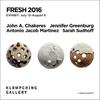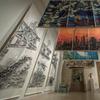New Discoveries from the Han Dynasty Show How China's Elite Had It All
- SAN FRANCISCO, California
- /
- January 29, 2017
Like the Roman Empire, China’s Han dynasty (206 BCE–220 CE) forged one of the most powerful, advanced civilizations of the ancient world, and its elite had it all: unbridled luxury, technical innovations and courtly romance. On February 17 the Asian Art Museum unveils Tomb Treasures: New Discoveries from China’s Han Dynasty, an original exhibition of more than 160 intriguing works recently unearthed from the coastal heartland of classical Chinese culture. On view through May 28, Tomb Treasures showcases these fresh archaeological finds, almost all never-before-seen outside of China.
Surviving over 2,000 years underground, such outstandingly crafted royal burial goods reflect Han royalty’s daily lives and nightly pastimes, and confirm how the early Chinese courts sought to glorify their statures in this life and in the next one. Building on international audiences’ interest in the world-famous Terracotta Warriors — presented in the Asian Art Museum’s wildly popular 2013 exhibition — Tomb Treasures features new discoveries from Jiangsu province, near present-day Shanghai. Through artworks and artifacts created from ceramic, lacquer, precious metal and priceless jade, Tomb Treasures tells a rich story of how early Chinese aristocrats deployed luxury to make their lives — and by extension their afterlives — as majestic and pleasure-filled as possible.
Co-curated by Jay Xu, director and CEO of the Asian Art Museum, and Fan Jeremy Zhang, the museum’s senior associate curator of Chinese art, the exhibition is organized into three areas themed according to popular Han-era adages found on various artifacts:
• Everlasting happiness without end (長樂未央): Luxurious life and palatial entertainment. Daily life, banquets and pastimes of the Han elites are accompanied by the music and dance of the court.
• Eternal life without limit (長生無極): Worship of jade and search for immortality. A tomb-like atmosphere allows visitors to explore ancient ideas about the afterlife.
• Enduring remembrance without fail (長毋相忘): Private life and intimacy at the court. Affairs of the heart expose secrets from the innermost chambers of men and women fascinated by pleasure.
“This exhibition underscores how connected we really are to the past, that we share the same passions across time and culture,” says Asian Art Museum director and exhibition co-curator Jay Xu. “These tomb treasures show how the Han people’s ambitions relate to our own pursuit of comfort and security today. The search for longevity, the craving for immortality, the yearning for a joyful life and a satisfying afterlife — is it the sweetness of this world that inspires our hopes for the next?”
Life and Death (and Sex and Sewers) Displayed for the First Time
Most of the artworks and objects featured in Tomb Treasures come from the looted mausoleums belonging to the Jiangdu Kingdom at Dayun Mountain, only excavated in 2011, and royal tombs of the Chu Kingdom at Xuzhou, first uncovered in 1995. Nearly untouched tombs of Han-era aristocrats are exceedingly uncommon and North American audiences have rarely had the opportunity to experience such a luxuriously detailed portrait of court life. “Death was merely an initiation into the afterlife,” explains Xu. “These underground palaces were furnished to provide everything the deceased would have needed to continue their grand existences — visitors will not only appreciate the innovation of the artistry and craftsmanship on display, but the very human aspirations they represent.”
Most of the works on view have never travelled before from their home museums in central China, and highlights of the Asian Art Museum’s presentation include: • An extravagant jade burial suit made up of hundreds of “fish scale” tiles and sewn with gold threads. Only a handful of these suits, thought by the Han to guard against decay, have ever been discovered.
• An exquisitely decorated lacquer and jade coffin, resplendent even after centuries underground and still revealing new secrets about its assembly.
• Ingenious bronze “smokeless” lamps that set the mood for evening revelry.
• Elegant bells that still ring, which were vital to state ceremonies and ancestorworship rituals. A replica set of chimes will be performed on by the museum’s partners from San Francisco’s Center for New Music every third Sunday.
• Ceramic dancers caught forever in a graceful pose, swaying to an unknown melody.
• Romantic silver belt hooks excavated from the tomb of a female consort, made of two interlocking pieces bearing the auspicious inscription “forget me not,” and fitting together in perfect harmony to literally become one for all eternity.
In addition to luxuries, royals also surrounded themselves with domestic wares that surprise us with their intimate reflection of private life and an abiding concern with grooming, hygiene, longevity and sex during the Han dynasty. “We have everything from a large silver basin for taking baths, to a working stone latrine with an armrest, to an elaborate ceramic urinal — we are even displaying two hollow bronze phalluses that could be worn and used,” says exhibition co-curator Fan Zhang. “This almost modern appreciation for the body’s needs and wants is something we think our open-minded visitors from San Francisco and around the Bay Area will especially enjoy learning about and sharing with friends!”
Information: 415.581.3500 or www.asianart.org




10270x400_c.jpg)













![Peter Paul Rubens (Flemish, 1577–1640), After Titian (Tiziano Vecelli) (Italian [Venetian], c. 1488–1576), Rape of Europa, 1628–29. Oil on canvas, 71 7/8 x 79 3/8 in. Peter Paul Rubens (Flemish, 1577–1640), After Titian (Tiziano Vecelli) (Italian [Venetian], c. 1488–1576), Rape of Europa, 1628–29. Oil on canvas, 71 7/8 x 79 3/8 in.](/images/c/e2/2e/Jan20_Rape_of_Europa100x100_c.jpg)



